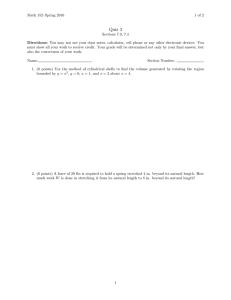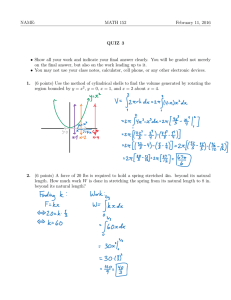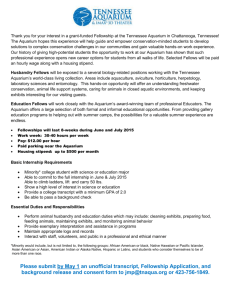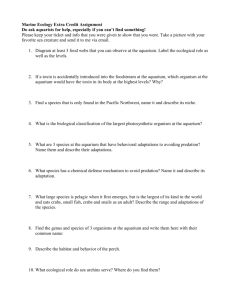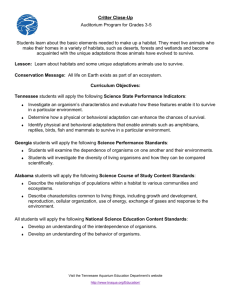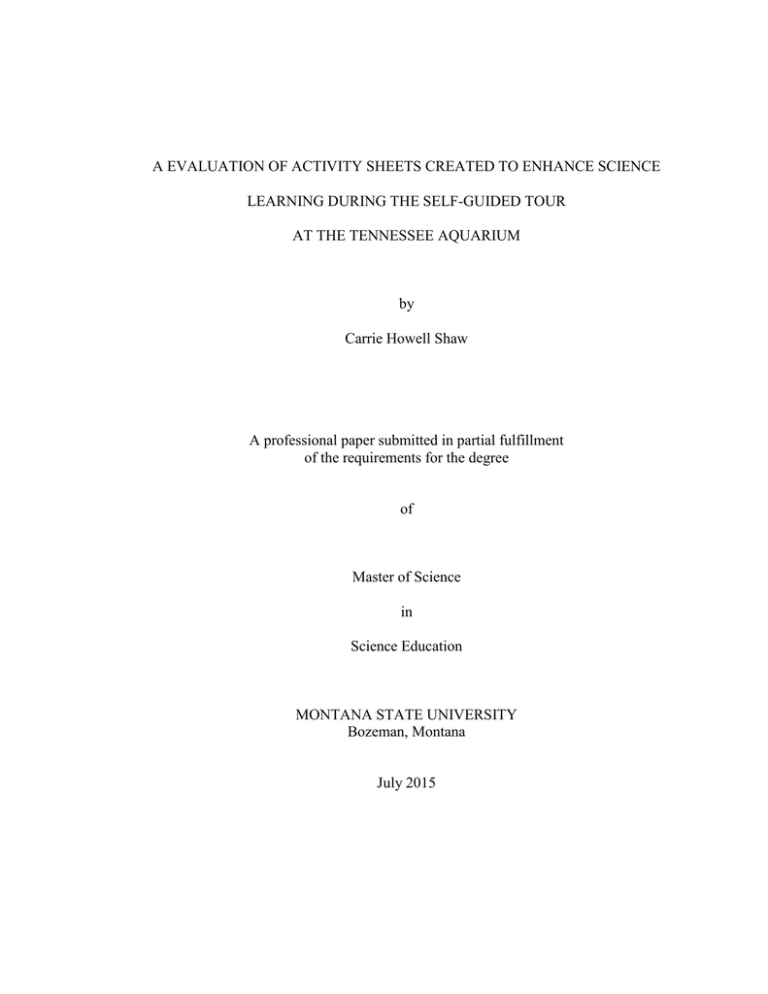
A EVALUATION OF ACTIVITY SHEETS CREATED TO ENHANCE SCIENCE
LEARNING DURING THE SELF-GUIDED TOUR
AT THE TENNESSEE AQUARIUM
by
Carrie Howell Shaw
A professional paper submitted in partial fulfillment
of the requirements for the degree
of
Master of Science
in
Science Education
MONTANA STATE UNIVERSITY
Bozeman, Montana
July 2015
©COPYRIGHT
by
Carrie Howell Shaw
2015
All Rights Reserved
ii
TABLE OF CONTENTS
1. INTRODUCTION AND BACKGROUND ....................................................................1
2. CONCEPTUAL FRAMEWORK ....................................................................................3
3. METHODOLOGY ..........................................................................................................6
4. DATA AND ANALYSIS ............................................................................…………..10
5. INTERPRETATION AND CONCLUSION .................................................................12
6. VALUE ..........................................................................................................................14
REFERENCES CITED ......................................................................................................17
APPENDICES ...................................................................................................................20
APPENDIX A Teacher Survey..............................................................................21
APPENDIX B AquaQuest .....................................................................................23
APPENDIX C Habitat Activity Sheet ...................................................................25
APPENDIX D Exhibit Ethogram ..........................................................................27
APPENDIX E Teacher Email ................................................................................29
APPENDIX F Institutional Board Approval .........................................................31
APPENDIX H Habitat Pre and Post-Test ..............................................................33
APPENDIX I Student Survey ................................................................................35
APPENDIX J Teacher Tools Screenshot ...............................................................37
iii
LIST OF TABLES
1. Data Triangulation Matrix .............................................................................................10
iv
LIST OF FIGURES
1. Percentage of Responses to Survey Query, “If Yes, Please List What Concepts Were
Covered.” ...........................................................................................................................11
2. Distribution of Observations Listed on Habitat Activity Sheets ...................................12
v
ABSTRACT
This project evaluated activity sheets that I created for the Tennessee Aquarium
based on Tennessee state science standards and the informal education model of freechoice learning. The research focused on one of the worksheets about habitats created
for second through fourth grade students. Teachers from those grades who were
scheduled to visit the Aquarium in the month of March were solicited to participate in the
study. Two teachers agreed to participant in different capacities. Based on the lack of
student enthusiasm and my evaluation of completed the activity sheets and student
surveys, I determined that the activity sheet was not effective at fostering learning or
interest. However, the activity sheets were effective when used by chaperones instead of
individual students. Additional research should be conducted to specifically evaluate
using chaperones to led activities during self-guided tours of the Tennessee Aquarium.
1
INTRODUCTION AND BACKGROUND
I work at the Tennessee Aquarium in downtown Chattanooga, TN within
Hamilton County. The 2012 census showed the city population of Chattanooga to be
167,896 with a demographic of 34.6% African American, 59.2% White, 5.9% Hispanic
or Latino, 2.1% Asian and 0.3% American Indian. The median income was $35,817
(http://quickfacts.census.gov/qfd/states/47/4714000lk.html). As a private non-profit, the
mission of the Tennessee Aquarium is to inspire wonder, appreciation, and protection of
water and all the life it sustains (http://www.tnaqua.org/about-us/). The education
department plays an important role in implementing that mission, as well as working
toward a departmental mission to create a future generation of science-literate and
environmentally knowledgeable citizens. Our hands-on, informal programming falls
under the umbrella of museum education, since the Aquarium displays a living collection.
Seventy to ninety thousand children visit the Tennessee Aquarium on field trips
every year from Tennessee, Alabama, Georgia, and North Carolina at a price that is 56%
less than a regular child admission. We provide free admission to students who qualify
for free or reduced lunch eight months out of the year and give over $40,000 in bus
reimbursements to Title I schools every school year. We also provide free outreach
programs to Title I schools in Hamilton County and give family passes, called Aquarium
Passports, to students at an intercity Environmental Science magnet school. The bus
reimbursement, complimentary admission, and passport programs, as well as the
generous education discount, are all testaments to the institution’s commitment to
reaching as many children as possible within a school year.
2
The Tennessee Aquarium opened in 1992 with one building, River Journey. A
typical field trip at the aquarium included a one-hour tour of the exhibits, a one-hour
education program, and lunch. In 2006, a second exhibit building, Ocean Journey, and an
IMAX theater were added. Extra time on field trips became much more limited with the
addition of a second one-hour long exhibits tour and the option to add a 45-minute IMAX
film. As such, the number of groups that schedule education programs with their exhibits
tour has dropped significantly since 2006. On the Teacher Survey sent out to teachers in
December 2014 and April 2015 (N=144), only 37% of teachers indicated that they
participated in some kind of classroom program during their field trip (Appendix A).
In December 2014, I was promoted from Education Coordinator to Group
Programs Manager. In this role, I supervise a staff of four full-time educators, three parttime naturalists, and eight summer camp seasonal workers. I manage all group
programming at the Aquarium including field trips, overnights, summer camp, outreach,
and daily Tennessee River gorge cruises. Since I am the first new manager since the
building of Ocean Journey and the IMAX Theater, the Education Director assigned me
the task of increasing our influence on students on field trips. This is especially
challenging since students are not in a classroom setting.
Several options are currently in place for classroom teachers to aid in student
learning during the self-guided exhibits tour. One that is frequently used is the
AquaQuest (Appendix B). It is a scavenger hunt that teachers can print and give to
students to complete during their tour. There are four AquaQuests available to download
on the Tennessee Aquarium website based on the grade of students
3
(http://www.tnaqua.org/teachers/teacher-resources/). The AquaQuests are light on
content and mostly involve looking for specific animals or facts from the graphic panels.
My change in role at the Aquarium, the challenge of assisting classroom teachers
and their students and our organization’s mission lead to the focus question of this study,
Will the creation of new activity sheets that fulfill teacher learning goals be effective to
motivate a future generation of science-literate citizens?
CONCEPTUAL FRAMEWORK
There is a national crisis of not enough people entering the science workforce.
Both the Obama and the Bush administrations have focused on the goal of increasing the
number of students pursuing high-level science and math. Globalization requires the
understanding of science and technology for most fields of work (Griffin &
Ramachandran, 2010). Improved science literacy will aid basic understanding about
what citizens read on the internet and other media, allowing the identification of errors
and design flaws as well as differentiating between claims and evidence (National
Research Council, 2012). It will help people solve meaningful problems in their lives
and might affect how they live their lives (Feinstein, 2010). Thus, improving science
literacy will help boost U.S. participation in the global scientific workforce as well as
benefiting the layperson.
Science literacy endeavors can start at a young age by exposing guiding children
to answer their natural questions about the world (Bell, Lewenstein, Shouse & Feder,
2009). The National Research Council outlines in Learning Science in Informal
Environments that developing motivation to learn science can be achieved by fostering
interest and emotional engagement among students. Hobby or interest groups, museum
4
exhibits, and after school programs support science learning by fostering interest and
excitement (Bell et al., 2009), which can lead to cognitive gains (DeWhitt & Hohenstien,
2009). Falk (2005) refers to these out-of-school learning places such as zoos, aquariums,
science centers, and museums as institutions of “free-choice learning,” since visitors
often make the choice to learn in these environments. He suggests that part of what
motivates students to learn in these environments is their empowerment to make choice
about what they learn. Griffin (2004) also found that museum learning is best facilitated
by giving students freedom of choice in how they spend their time.
Alternatively, Bamberger and Tal found in their 2006 study of 750 students in
four Isreali museums that “limited choice” learning environments created the best
outcome of learning over “free choice” and “no choice.” In their study, free choice
situations allowed the students unstructured reign of their environment. Limited choice
included times when the students had worksheets to complete and when they had a
problem or task to solve with their peers. No choice situations were guided museum
tours with little to no inquiry included. The depth of interactions between students was
the greatest with guidance in the limited choice situations, as opposed to mostly
expressions of excitement in the free choice situations (Bamberger & Tal, 2006).
In addition to choice, inquiry is also important tool in formal and informal science
education. One of the basic premises of science literacy is that “critical thought and the
ability to explore questions are more important than learning answers by rote” (Roush,
1996, p. 1356). Informal learning centers can be a place to explore those student
questions. Classroom teachers and museum educators can impede that process by
5
mimicking the formal environment in the informal (Griffin, 2004), although some use of
formal questioning and reminders to focus can aid in student learning. DeWhitt and
Hohenstein (2009) found that museum learning is best when students are guided in their
learning, but not over-programmed. They concluded that students benefited from a
combination of student-directed questioning and teacher-directed questioning, based on
their findings that student-directed questioning led to increased cognition and that
teacher-directed questioning led a deeper understand of content.
In selecting content for informal learning experiences, teachers should link the
visit to current classroom curriculum and have adults with some content knowledge
accompanying the students (Gilbert & Prest, 1997). In general, Griffin and
Ramachandran (2010) suggest that teachers should cover fewer topics in greater depth to
create lifelong learners of science. They support their research with the approach of
studying broader topics, like conservation and energy, which can be broken down into
more specific topics to help understand the ideas more thoroughly.
While there is not a consensus on best practices for informal learning experiences,
there is a large body of research supporting that they are an important tool in the overall
science learning of students and adults. It is clear that field trips should be based on
previous learning the classroom and answer big questions, they should be guided by
structured inquiry, and they give students more freedom to explore than they are allowed
in a classroom.
6
METHODOLOGY
Background Research and Worksheet Creation
Based on my research of best practices for learning in informal environments, last
spring I created several standards-driven activities, including the Habitat Activity Sheet
used in this research, which were less rigid than the AquaQuests and more closely
followed the museum model of free-choice learning (Appendix C). In additional to
habitats, these covered the content of biomes and adaptations. They were created to meet
teacher learning goals and focus students to learn more deeply at exhibits of their
choosing. They were also intended to have students connecting more with nature by
creating a sustained interaction and closer observation at those exhibits.
After creating the Habitat Activity Sheet and other activity sheets, I observed a
free-choice self-guided tour of a fourth-grade group from a neighboring county who were
not guided by adults using inquiry, had not been given tasks for touring, and did not have
worksheets to complete. I was not wearing a uniform that day and did not interact with
the group in any way. I took notes about the length of time they spent at exhibits, the
number of related and unrelated questions they asked their peers and chaperones, and the
number of related and unrelated comments they made to their peers and chaperones. I
counted each window as an exhibit stop. I used the Exhibit Ethogram to tally these
interactions at each exhibit (Appendix D). For background information, I also examined
the data collected by the marketing department from this school year’s Teacher Survey
(Appendix A).
7
Group Solicitation
I solicited groups to participate in the study using the reservations system to
collect email addresses of teachers planning to visit the Aquarium in March, 2015 and
sent the Teacher Email to prospective teachers (Appendix E). Of 45 emails sent, two
teachers responded stating they would participate. For the purposes of this paper, the
teachers and their students are referred to as Group A and Group B. Group A was 24
second grade students from a rural county in Tennessee. Group B was a fourth grade
group of 32 students from north Georgia who were scheduled to participate in an
educator-led classroom program about plankton before their self-guided tour. The
research methodology for this project received an exemption by Montana State
University's Institutional Review Board and compliance for working with human subjects
was maintained (Appendix F).
Data Collection Instruments
I used three main instruments for collecting data in this project. These included
the Habitat Activity Sheet (Appendix C), Habitat Pre and Post-Tests (Appendix H), and
the Student Survey (Appendix I). I tallied data in Google Sheets and used R statistical
software to test for statistical significance. I chose non-parametric tests due to the small,
non-random sample size of this study.
The Habitat Activity Sheet was selected as the appropriate activity sheet for the
participating second and fourth grade groups. On the Habitat Activity Sheet from Groups
A and B, I calculated the number of observations listed per habitat on completed
8
worksheetsand compared those data sets using a Mann-Whitney test. I also tallied who
did and did not complete the activity sheet when given the option.
The Habitat Pre and Post-Tests were administered to Group B. Answers were
coded as relevant or non-relevant. I calculated the percent of correct answers on each test
and compared the averages on both tests using a Barnard’s Exact Test.
Both Group A and Group B completed the Student Survey. I also administered
the Student Survey to non-participating students chosen randomly as they ended their
self-guided exhibits tour. I focused my analysis of the Student Survey on two questions:
“Name something cool you learned at the Aquarium today,” and “Do you have any
questions about what you saw today?” I coded the survey answers from the general
student population and Group B as relevant or non-relevant/no answer. For each of the
two questions, I compared the students who had completed the Habitat Activity Sheet or
a teacher-created scavenger hunt to those who had completed no written activity using
Barnard’s exact test for 2x2 contingency tables.
Implementation
The teacher of Group A agreed to have her 24 students use the Habitat Activity
Sheet during their self-guided tour, fill out the attached Student Survey, and then mail the
materials to me. This teacher did not agree to have her students complete the Habitat Pre
and Post-Test. After receiving the worksheets and surveys in the mail, I clarified with the
teacher by phone why there were only eight worksheets returned for the group’s 24
students. The teacher told me that chaperones conducted the Habitat Activity Sheet with
small groups of students. The chaperones also filled out the Student Survey instead of
9
the students, so the survey data was not useful to compare to the other groups. For her
efforts, I mailed her classroom an otter poster and a set of animal cards.
I agreed to meet Group B in the morning to issue the Habitat Pre-Test. I
requested that only half of this class complete the Habitat Activity Sheet so that I could
evaluate differences in the group that did the activities and the group that did not. She
did not facilitate this and many of the students were unwilling to participate without a
teacher mandate. Therefore, only ten students in Group B took a Habitat Activity Sheet
and clipboard. Before the Group B’s IMAX film at the end of the day, I was able to
administer the student survey and post-test to these students. Only four of the ten
students returned a completed activity sheet, some stating that they lost it and others
stating that they forgot. I conducted the Habitat Post-Test and Student Survey in a
classroom after they ate lunch and before their IMAX movie.
I collected 16 additional Student Surveys from students from random groups
visiting in the same month by standing at the exit of River Journey for an hour one day
and at the exit of Ocean Journey for an hour another day. I asked students to take a
survey while they waited for their group to finish their tour. I was unable to identify
which groups the students were touring, so asked for their grade level and whether or not
they had completed a worksheet or scavenger hunt that day at the top of these surveys.
Table 1 highlights the triangulation of data for the study.
10
Table 1
Data Triangulation Matrix
Focus Question
1
2
1. What are teachers and students currently
getting out of field trips?
Teacher Survey
Ethogram
2. Do new standards-focused written activities
help teachers meet learning goals?
Habitat Pre and
Post-Test
Habitat Activity
Sheet
3. Do new standards-focused written activities
help the aquarium meet its science literacy
goals?
Habitat Activity
Sheet
Student Survey
DATA AND ANALYSIS
On the Exhibit Ethogram used to study student behavior on field trips, I recorded
23 exhibit stops, which had an average length of 30 seconds. Students stayed for 4.5
minutes at an exhibit in which a scuba diver was cleaning and stayed an average of three
minutes at each touch tank. The most content related questions I heard were at the tank
with the scuba diver, such as “How did he get in there?” The most content related
comments I heard were at the touch tanks, including many observations on how they fish
felt. The students asked more content related questions in the freshwater building, but
made more excited comments in the saltwater building, such as exclamations of “Shark!”
and “Sea Turtle!”
On the Teacher Survey (N=144), 61% of respondents indicated that their visit to
the Aquarium supplemented a specific classroom lesson. Of the teachers who comments
on what concepts were covered (N=80), the most common concept mentioned was
11
habitats/biomes, followed by lesson about specific animals or groups of animals and
taxonomy or classification lessons (Figure 1).
Figure 1.Percentage of responses (N=80) to survey query, “If yes, please list what
concepts were covered.”
On the Habitat Pre-Test from Group B, 96% of students demonstrated that they
understood the definition of a habitat (N=24). On the post-test from Group B, 74% of
students were able to make connections about why a seahorse could not live in freshwater
or the desert (N=24). There was no significant difference (p=0.50, Barnard’s Exact Test)
in performance on the post-test for the students doing the habitat activity (N=4) compared
to the group not completing the activity (N=20).
Of the students who completed a worksheet (N=8), 88% had a relevant response
to the query, “Name something you learned at the Aquarium today,” compared to 72% of
the students who had not completed a worksheet (N=32). No significant difference was
found between these two groups (p=0.22). Of the worksheet students (N=8), 50%
generated a relevant question when prompted, “Do you have any questions about what
12
you saw today?” and of the no worksheet students (N=32), 37.5% generated a relevant
question. This was not a statistically significant difference in answers.
On the Habitat Activity Sheets, the chaperone-led worksheets from Group A
(N=8) had an average of three observations per habitat and the students-directed
worksheets from Group B (N=4) had an average of one observation per worksheet
(Figure 3). The distribution of this data was found to be significant at an alpha level of
Average number of
observations per habitat
0.05 using the Mann-Whitney test for non-normally distributed data (p=0.02).
4th Grade
Individuals
2nd Grade
Groups
Figure 2.Distribution of observations listed on Habitat Activity Sheets (Appendix C)
completed by 4th grade individuals (N=4) versus 2nd grade chaperone-led groups (N=8).
INTERPRETATION AND CONCLUSION
During my observation of a self-guided tour, I found that students were on-task
for the majority of their tour. Their interest peaked at the scuba diver, which they might
13
not have been expecting, and waned after 45 minutes of touring. They also stayed longer
and talked more at the touch tanks where they got to interact with live animals.
Even though a majority of teachers who completed the Teacher Survey stated that
they were supplementing a specific classroom lesson, the standards-driven activity that I
created was a difficult sell to teachers. From informal conversations with teachers during
this research, I found that they mostly use scavenger hunts as an activity to focus
students, but preferred not to make them so challenging that they are not having fun that
day. I had one teacher from a prestigious private school in Chattanooga tell me that she
used the middle school AquaQuest for high school honors chemistry class because the
high school scavenger hunt was too challenging for a field trip day.
Even though it was not my intention, I found that the Habitat Activity Sheet
worked better as a chaperone led activity instead of asking students to remember to do
the activity themselves. The content produced when chaperone-led was of higher quality
than what the students produced independently. This hopefully led to a greater
understanding of the connection between animals and the habitats, although this
statement cannot be evaluated conclusively since the teacher opted out of pre and posttests for this group.
The California Academy of Sciences experimented with chaperone-led activities,
but whether or not it was helpful to aid learning was inconclusive (Burtnykn& Combs,
2005). In introducing her research on the role of chaperones in museum visits, Wood
(2010) noted that most research on student cognition in museums ignored the role of
chaperones, even though it supported the importance of social interaction. She found that
14
many external factors affected the role of chaperone on field trips, such as level of
education, comfort with the museum space, and perceptions about museums.
Overall, research on learning in informal science education facilities is conclusive
that teacher involvement and fostering student interest is crucial to student learning on
field trips (Fenichel & Schweingruber, 2010). Dohn (2011) published research on
situational interest of high school students on an aquarium visit. He found that hands-on
activities using live animals, surprising or novel events, social involvement, and support
for learning were the main influences to situational interest. Instead of just focusing on
free-choice, future activities created to enhance the self-guided exhibit tour need
incorporate research-backed suggestions such as these for driving interest. More work
should also be done to create teacher buy-in for future activities.
VALUE
While my undergraduate capstone work focused on the importance of informal
science education and the role of the educator, this research focused more specifically on
the role of an education department at an informal institution. This was in-line with my
recent promotion to Group Programs Manager. While this study looked specifically at
improving the AquaQuest, the background research and data collected also has
implications for all group programming. It reminded me that it is important to keep
activities and programming fun, not just to please teachers and parents, but also because
that is the most effective way for us to utilize our unique role as an informal facility to
inspire children to want to learn while on their field trip and when they get back to the
15
classroom. I would like to explore the possibility of using my conceptual framework as a
starting point to develop a teacher workshop on field trip best practices.
I intended to create an activity in which children would choose galleries to
complete the open-ended task. When given free-choice, the students mostly choose to
not complete the activity. If I had chance to redo my research project, I would create a
more visually appealing worksheet and use marketing tools such as the teacher enewsletter and social media to promote it. However, I had no conclusive data from the
Habitat Pre and Post-Tests or Student Survey that supported enhanced student learning or
interest when using the activity sheets on their own.
Because of this, I have adapted the activity sheets that I created as student-led
activities to be chaperone-led activities and have posted them on the Tennessee
Aquarium’s “Teacher Resources” webpage (Appendix J,
http://www.tnaqua.org/teachers/teacher-resources/). I have discussed the possibility of
field trip use for the Tennessee Aquarium mobile app. The technology team hopes to
develop mobile chaperone guides using the aquarium’s beacon system, which ping
smartphones with exhibit-specific information as guests walk past those exhibits. I have
also taken over the role of coordinating our partnership with a local museum magnet
school in hopes that I can use the chaperone-driven, small group work that the school
does in specific exhibits as a model for other groups.
The exhibit ethogram that I created was an excellent tool for keeping track of
student interactions at exhibits. I plan to use interns in the fall to collect data about
student interactions at exhibits. Hopefully this additional data will help me draw
16
conclusions about the best timing for educator interactions, as well as the importance of
education interactions and the usefulness of worksheets and chaperone guides. Once I
determine the best way for groups to foster learning on their field trips, I will hopefully
be able to offer incentives to education groups for participation. I continue to work on
improving the reservation process for teachers, which will hopefully leave them with
more time to plan their content. We are a mission-driven organization that already offers
many programs to aid groups in providing field trips for all students, so I feel that the
administration will be on-board with research-backed suggestions from the education
department.
17
REFERENCES CITED
18
Bamberger, Y. and Tal, T. (2006). Learning in a personal context: Levels of choice in a
free choice learning environment in science and natural history museums. Science
Education, 91(1), 75-95.
Bell, P., Lewenstein, B., Shouse, A.W. &Feder, M.A. (Eds.) (2009) Learning Science in
Informal Environments: People, Places, and Pursuits. Washington, DC: The
National Academies Press.
Burtnyk, K.M. & Combs, D.J. (2005) Parent chaperones as field trip facilitators: A case
study. Visitor Studies Today, 8(1), 13-20.
DeWitt, J. &Hohenstein, J. (2009). School Trips and Classroom Learning: An
Investigation into Teacher-Student Talk in Two Settings. Journal of Research in
Science Teaching, 454-473.
Dohn, N. (2011). Situational Interest of High School Students Who Visit An Aquarium.
Science Education, 337-357.
Falk, J. H. (2005). Free-choice environmental learning: framing the discussion.
Environmental Education Research, 11(3), 265-280.
Feinstein, Noah. (2010).Salvaging Science Literacy.Science Education, 168-185.
Fenichel, M. & Schweingruber, H. (2010) Surrounded by Science: Learning Science in
Informal Environments.Washington, DC: National Academy of Sciences.
Gilbert, J. & Priest, M. (1997). Models and discourse: A primary school science class
visit to a museum. Science Education, 749-762.
Griffin, J. (2004). Research on Students and Museums: Looking More Closely at the
Students in School Trips. Science Education, S59-S70.
Griffin, K. &Ramachandran, H. (2010). Science Education and Information Literacy: A
Grass-Roots Effort to Support Science Literacy in Schools. Science & Technology
Libraries, 325-349.
National Research Council. (2012) A Framework for K-12 Science Education: Practices,
19
Crosscutting Concepts, and Core Ideas. Washington, DC: The National
Academies Press.
Roush, Wade. (1996). Putting Museumgoers in Scientists’ Shoes. Science 271(5254),
1356.
Wood, Elizabeth (2010). Defining the Chaperone’s Role as Escort, Educator or
Parent.Visitor Studies, 160-174.
20
APPENDICES
21
APPENDIX A
TEACHER SURVEY
22
Teacher Survey (some questions included at imperative of marketing)
1.
Please rate your overall field trip experience.
5 - Excellent, 4 - Good, 3 - Neutral, 2 - Fair, 1 – Poor
2.
What month do you typically plan your field trip?
3.
What month do you start the planning process?
4.
Did you access the Tennessee Aquarium website prior to booking your
reservation?
Yes, No
If yes, please let us know what we can do to improve the user-friendliness of our
website.
5.
Did you download and of the following educational resources from our website?
Check all that apply:
Aqua Quest, Aqua Guide, Food Webs, IMAX Resource Guide, Dichotomous
Keys, Biome or Habitat Tour
6.
Did your Aquarium visit supplement a specific classroom lesson?
Yes, No
If yes, please list what concepts were covered.
7.
Did you take advantage of any of the following free educational programs?
Lunch and Learn, Classroom Program, Auditorium Program
If yes, please comment on your program experience.
8.
Please tell us what we can do to improve the reservation process.
9.
What grade do you teach? (Check all that apply)
Preschool, Elementary, Middle School, High School, College
10.
Where do you teach?
Public school, private school, home school
23
APPENDIX B
AQUAQUEST
24
25
APPENDIX C
HABITAT ACTIVITY SHEET
26
Tennessee Aquarium Habitat Tour
What is a habitat?
Many of the exhibits at the Tennessee Aquarium are made to look and feel just like
certain habitats. Make a list of the habitats you experience while you tour the
Aquarium. For each habitat, list two animals that live there and any adaptations
that you notice that help it live there.
Habitat:
Animal:
Animal:
Observations:
Observations:
27
APPENDIX D
EXHIBIT ETHOGRAM
28
All answers counts except first. Comment define as words or phrases combined in a
single thought.
Length of interaction
Student asks a related question to adult
Student asks an unrelated question to adult
Student asks a related question to a peer
Student asks an unrelated question to a peer
Student makes a related comment to adult
Student makes an unrelated comment to adult
Student makes a related comment to peer
Student makes an unrelated comment to peer
Length of interaction
Student asks a related question to adult
Student asks an unrelated question to adult
Student asks a related question to a peer
Student makes a related comment to adult
Student makes an unrelated comment to adult
Student makes a related comment to peer
Student makes an unrelated comment to peer
29
APPENDIX E
TEACHER EMAIL
30
At the Tennessee Aquarium, we’re working hard to make sure that children are learning while
they are on field trips to our facility. We fund $40,000 a year worth of bus reimbursement out
of our operating budget and get many grants from the community to bring economically
disadvantaged children to the Aquarium because we believe that the enthusiasm about science
and appreciation of nature learned at Tennessee Aquarium is important. I would greatly
appreciate it if you would take the time to use the attached activity sheet while you tour the
Aquarium. If you leave them for me at the exit or mail them to me after you grade them, I will
be happy to mail a set of animal trading cards and several otter posters to your classroom as a
thank you. This tool is one of several ways that we are evaluating to enhance the learning
experience of the self-guided tour at the Tennessee Aquarium. If you have ideas or examples of
things that work for your class, please let me know!
Thanks for helping us better serve your students in the future.
Carrie Howell Shaw
Group Programs Manager
Tennessee Aquarium
(423) 785-4050
201 Broad Street, Suite 200
Chattanooga, Tennessee 37402
The Tennessee Aquarium inspires wonder, appreciation and protection of water and all life that it sustains.
31
APPENDIX F
INSTITUTIONAL BOARD APPROVAL
32
33
APPENDIX H
PRE AND POST TEST
34
Pre-test:
1. What is a habitat?
________________________________________________________________________
Post-test:
Imagine a seahorse living in a saltwater habitat where there is lots of seaweed. Name two
reasons why that seahorse would not be able to survive if you moved it to a rocky lake.
1.
2.
Name two reasons why that seahorse would not be able to survive life in a desert.
1.
2.
35
APPENDIX I
STUDENT SURVEY
36
1.
Name something cool you learned at the Aquarium today.
2.
What’s one more thing you learned?
3.
If the Aquarium was a classroom, what subject would it be?
4.
List what kind of jobs that you think people have at the Aquarium.
Name one thing you can do to help the earth.
37
APPENDIX J
TEACHER TOOLS SCREENSHOT
38

